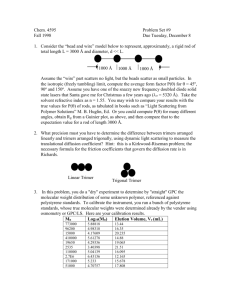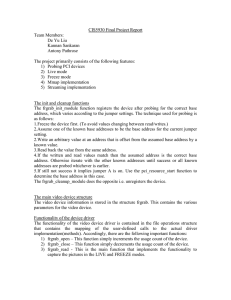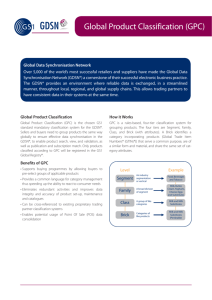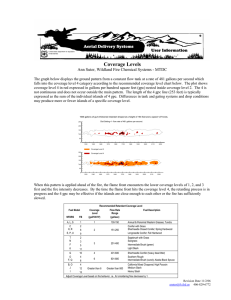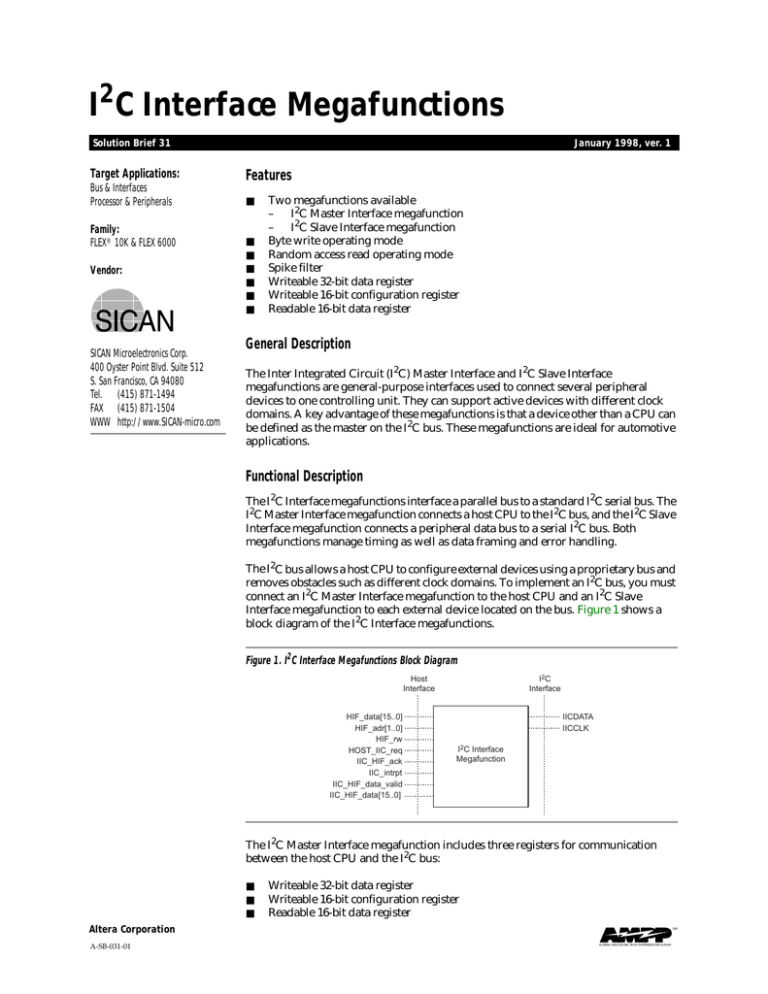
I2C Interface Megafunctions
Solution Brief 31
Target Applications:
Bus & Interfaces
Processor & Peripherals
Family:
FLEX® 10K & FLEX 6000
Vendor:
SICAN Microelectronics Corp.
400 Oyster Point Blvd. Suite 512
S. San Francisco, CA 94080
Tel. (415) 871-1494
FAX (415) 871-1504
WWW http://www.SICAN-micro.com
January 1998, ver. 1
Features
■
■
■
■
■
■
■
Two megafunctions available
–
I2C Master Interface megafunction
–
I2C Slave Interface megafunction
Byte write operating mode
Random access read operating mode
Spike filter
Writeable 32-bit data register
Writeable 16-bit configuration register
Readable 16-bit data register
General Description
The Inter Integrated Circuit (I2C) Master Interface and I2C Slave Interface
megafunctions are general-purpose interfaces used to connect several peripheral
devices to one controlling unit. They can support active devices with different clock
domains. A key advantage of these megafunctions is that a device other than a CPU can
be defined as the master on the I2C bus. These megafunctions are ideal for automotive
applications.
Functional Description
The I2C Interface megafunctions interface a parallel bus to a standard I2C serial bus. The
I2C Master Interface megafunction connects a host CPU to the I2C bus, and the I2C Slave
Interface megafunction connects a peripheral data bus to a serial I2C bus. Both
megafunctions manage timing as well as data framing and error handling.
The I2C bus allows a host CPU to configure external devices using a proprietary bus and
removes obstacles such as different clock domains. To implement an I2C bus, you must
connect an I2C Master Interface megafunction to the host CPU and an I2C Slave
Interface megafunction to each external device located on the bus. Figure 1 shows a
block diagram of the I2C Interface megafunctions.
Figure 1. I2C Interface Megafunctions Block Diagram
I2C
Interface
Host
Interface
HIF_data[15..0]
HIF_adr[1..0]
HIF_rw
HOST_IIC_req
IIC_HIF_ack
IIC_intrpt
IIC_HIF_data_valid
IIC_HIF_data[15..0]
IICDATA
IICCLK
I2C Interface
Megafunction
The I2C Master Interface megafunction includes three registers for communication
between the host CPU and the I2C bus:
■
■
■
Writeable 32-bit data register
Writeable 16-bit configuration register
Readable 16-bit data register
Altera Corporation
A-SB-031-01
SM
ALTERA MEGAFUNCTION PARTNERS PROGRAM
ALTERA MEGAFUNCTION PARTNERS PROGRAM
SB 31: I2C Interface Megafunctions
Writeable 32-Bit Data Register
The 32-bit writeable data register consists of two 16-bit registers,
data_reg_high[31..16] and data_reg_low[15..0], that handle the 16-bit data bus
of the host CPU. At the beginning of a read/write access, the CPU loads the 32-bit data
register with the data required to transfer data on the I2C bus. This information consists
of a 7-bit device code, an 8-bit address, 8 bits of data, and read/write bits. The
remaining bits are unused. The data transfer on the I2C bus always begins when
data_reg_low[15..0] has been loaded.
Writeable 16-Bit Configuration Register
The 16-bit writeable configuration register contains configuration information, such as
interrupt masking, that can be changed by the host CPU. This register includes the
reference frequency for the clock signal generation for the I2C bus. The I2C Interface
megafunction supports 90-kHz frequency in the standard mode.
Readable 16-Bit Data Register
The 16-bit readable data register contains the 8-bit data received from the I2C bus in
random access read mode. This register also contains an error bit, an interrupt bit, and
a write-allowed bit. The error bit signals a failed data transfer, and the interrupt bit
signals that the register has new data that must be read by the host CPU. The interrupt
bit is generated without respect to the irq bit in the configuration register.
The IICCLK signal can be stalled by any I2C device to prevent data from being
transmitted via the I2C bus. If the IICLK signal is stalled during a write access, the next
write access will not be acknowledged. To prevent this event, the 16-bit readable data
register provides a write-allowed bit, which is set to 0 to indicate that the writeable
32-bit data register is ready for a new write access.
Ports
Tables 1, 2, and 3 describe both megafunctions’ global signals, interface signals to the
host CPU, and interface signals to the I2C bus, respectively.
Table 1. I2C Interface Megafunctions Global Signals
Name
Type
Description
clk_27
Input
27-MHz clock signal.
Reset_n
Input
Active-low synchronized reset signal.
Table 2. Interface Signals to the Host CPU
Name
2
Type
Description
HIF_data[15..0]
Input
16-bit data bus from the host CPU.
HIF_adr[1..0]
Input
2-bit address bus.
HIF_rw
Input
Read/write select. A 0 indicates a write, and a 1
indicates a read.
HOST_IIC_req
Input
Host CPU requests for the next read/write access
IIC_HIF_ack
Output
Acknowledge. The I2C Interface megafunction is
ready for a new request.
IIC_intrpt
Output
Interrupt. Data must be read from the data register of
the I2C Interface megafunction.
IIC_HIF_data_valid
Output
Data valid on the bus.
IIC_HIF_data[15..0]
Output
16-bit data bus to the host CPU.
Altera Corporation
SB 31: I2C Interface Megafunctions
Table 3. Interface Signals to the I2C Bus
Name
Type
Description
IICDATA
Input/Output
Data for the I2C Interface megafunction.
IICCLK
Input/Output
Clock for the I2C Interface megafunction.
Utilization
Tables 4 and 5 describe both megafunctions’ logic cell requirements for FLEX 10K and
FLEX 6000 devices.
Table 4. I2C Master Interface Megafunction Logic Cell Requirements
Device Family Smallest Device Speed Grade
Logic Cells
EABs (1)
fMAX (MHz)
Availability
FLEX 10K
EPF10K20
-3, -4
243
0
39
Now
FLEX 6000
EPF6016
-2
308
–
29
Now
EABs (1)
fMAX (MHz)
Availability
Table 5. I2C Slave Interface Megafunction Logic Cell Requirements
Device Family Smallest Device Speed Grade
Logic Cells
FLEX 10K
EPF10K20
-3, -4
122
0
38
Now
FLEX 6000
EPF6016
-2
135
–
32
Now
Note to tables:
(1)
EAB = embedded array block
Deliverables
The I2C Interface package includes the following for each megafunction:
■
■
■
MAX+PLUS® II Text Design File (.tdf) netlist
MAX+PLUS II Parameterized Symbol File (.sym)
Engineering documentation
–
Interface description
–
Sample application
–
Configuration register
–
Timing diagrams
For more information on the I2C Interface package, contact SICAN Microelectronics
directly.
®
101 Innovation Drive
San Jose, CA 95134
(408) 544-7000
http://www.altera.com
3
Copyright 1998 Altera Corporation. Altera, MAX, MAX+PLUS, MAX+PLUS II, FLEX, FLEX 10K, FLEX 6000, EPF10K20, EPF6016, and
AMPP are trademarks and/or service marks of Altera Corporation in the United States and other countries. Other brands or products are
trademarks of their respective holders. The specifications contained herein are subject to change without notice. Altera assumes no
responsibility or liability arising out of the application or use of any information, product, or service described herein except as expressly
agreed to in writing by Altera Corporation. Altera customers are advised to obtain the latest version of device specifications before relying on
any published information and before placing orders for products or services. All rights reserved.
Altera Corporation

